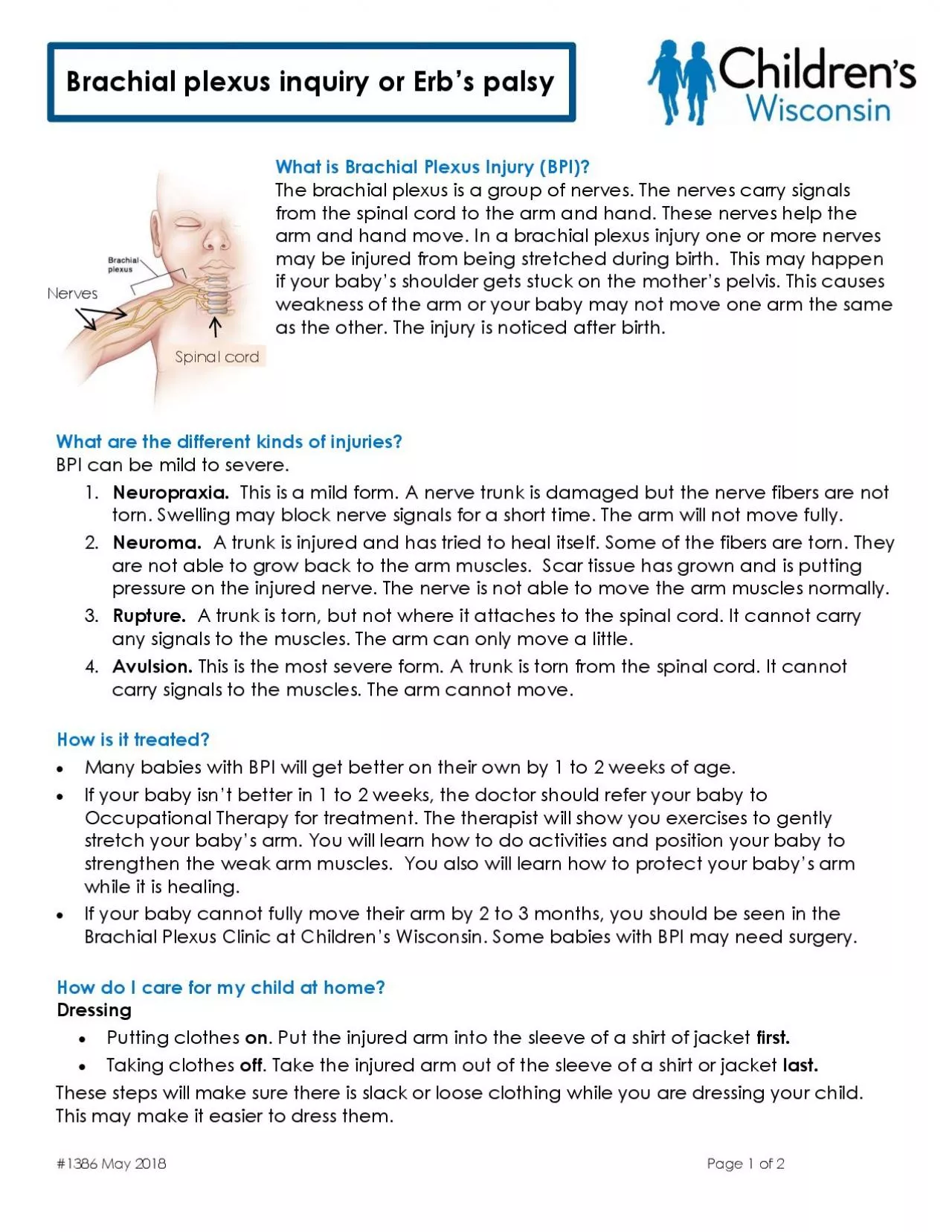/


1386 M a y 2018 Page 1 of 2 B rachial or E r b s p alsy What is B rachial Plexus Injury BPI The brachial plexus is a group of nerves The nerves carry signals from the spinal cord t ID: 953494
Download Pdf The PPT/PDF document "plexus inquiry" is the property of its rightful owner. Permission is granted to download and print the materials on this web site for personal, non-commercial use only, and to display it on your personal computer provided you do not modify the materials and that you retain all copyright notices contained in the materials. By downloading content from our website, you accept the terms of this agreement.
# 1386 M a y 2018 Page 1 of 2 B rachial plexus inquiry or E r b â s p alsy What is B rachial Plexus Injury (BPI)? The brachial plexus is a group of nerves . The nerves carry signals from the spinal cord to the arm and hand . These nerves help the arm and hand move . In a brac hial plexus injury o ne or more nerves may be injured from being stretch ed during birth. This may happen if your babyâs shoulder gets stuck on the motherâs pelvis. This causes weakness of the arm or your baby may not move one arm the same as the other. The injury is noticed after birth. What are the different kinds of injuries? BPI can be mild to severe. 1. Neuropraxia . This is a mild form. A nerve trunk is damaged but the nerve fibers are not torn. Swellin g may block nerve signals for a short time . The ar m will not move full y . 2. Neuroma . A trunk is injured and has tried to heal itself. Some of the fibers are torn . They are not able to grow back to the arm muscles . S car tissue has grown and is putting pressure on the injured nerve. The nerve is not able to move the arm muscles normally. 3. Rupture . A trunk is torn, but not where it attaches to the spinal cord. It cannot carry any signals to the muscles . The arm can only move a little . 4. Avulsion . This is the most severe form. A trunk is torn from the spinal cord . It cannot carry signals to the muscles. The arm cannot move. How is it treated? ï· Many babies with BPI will get better on their own by 1 to 2 weeks of age. ï· If you r baby isnât better in 1 to 2 weeks , the doctor should refer your baby to Occupational Therapy for t reatment . The t
herapist will show you exercises to gentl y stretch your babyâs arm. You will learn how to do activities and posi tion your baby to strengthen the weak arm muscles . You also will learn how to protect your babyâs arm while it is h ealing . ï· If your baby cannot fully move their arm by 2 to 3 months, you should be seen in the Brachial Plexus Clinic at Childrenâs Wisconsin . Some babies with BPI may need surgery. How do I care for my child at home? D ressing ï· Putting clothes o n . Put the injured arm into the sleeve of a shirt of jacket first. ï· Taking clothes off . Take the injured arm out of the sleeve of a shirt or jacket last. These steps will make sure there is slack or loose clothing while you are dressing your child. This may make it easier to dress them. Nerves Spinal cord N e rves #1386 M a y 2018 Page 2 of 2 Childrenâs Wisconsin ⢠PO Box 1997 ⢠Milwaukee, WI 53201 - 1997 ⢠childrenswi .org © 2020 Childrenâs Wisconsin. All rights reserved. P icking up the baby ï· Do not hold your baby under the arm pits. ï· Pick them up from under the head/neck and bottom. ï· Pick them up while holding onto their lower trunk and ribs. ï· Do not pull your child up from the floor or chair by their arms while holding their hands. A LERT: Call your childâs doctor or therapist if you have any questions or concerns or if your child has special health care needs that were not covered by this information. This sheet was created to help you care for your child or family member . It does not take the place of medical care. Talk with your healthcare pr ovider for diagnosis, treatment and follow - up.